Common Chrome on Mac problems + fixes
Mac Battery Draining Fast
Chrome is known for its fast performance, which it gets by using your Mac’s CPU more than other browsers. But more CPU usage means more battery drain. If you use your laptop on the go, this can become a huge issue. What good is performance if your battery is completely drained and you can’t turn on your Mac?
If Mac battery life is important to you, then there’s a simple trick that should be a big help. Often there is a tab or an extension that is hogging your resources and burning through your battery life by itself.
Follow these steps to find the offending site or extension:
- Open Chrome and click on the Settings icon (three lines on top of each other)
- Click on More Tools > Task Manager
- In Task Manager click the Memory column to sort them

Now you can determine what sites and extensions use up the most memory in Chrome. You can still visit one of these sites but maybe don’t leave it open in a tab anymore. Also remember that even sites that aren’t memory hogs can still be a battery drain if you have a lot of tabs open.
Close resource-hungry and unnecessary tabs and the time you get from a battery charge should start to improve.
Chrome Slow & Freezing
Does Chrome on your Mac feel like browsing through a swamp? If browser responsiveness is slowing, even to the point of Chrome freezing, it’s time to drain the swamp.
Why is Google Chrome so slow? We mentioned earlier that Chrome is resource-heavy, especially on your CPU. Chrome is fast when your Mac has the resources available, but when they are limited, and Chrome is demanding more than your Mac can give – swamp time.
The tip from Mac Battery Draining Fast will help a lot, but if you’re still experiencing slowness or Chrome keeps freezing, there are other fixes you can turn to.
Let’s start by focusing on cache. Chrome loves storing lots of your web browsing data. At first, it can help speed things along, but soon Chrome’s pockets are being weighed down by cache, particularly if your Mac is low on space or memory.
To manually delete your Chrome cache on Mac:
- Open Chrome and go to Settings > More Tools > Clear Browsing Data
- Select Clear Browsing Data
- Check the history, cache, cookie and other types of browser data that you want to delete
- Click Clear Browsing Data
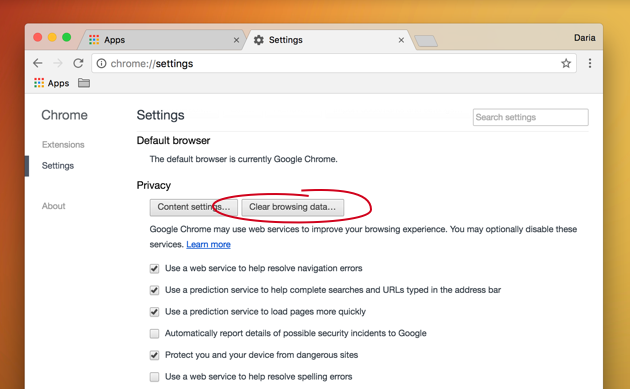
There’s another method for clearing out your cache, cookies, browser history, autofill form data and a whole lot more. You can use CleanMyMac 3. There’s surely no easier way to manage not just the cache that’s slowing down Chrome, but also your privacy and security – if these things are important to you (they should be).
To delete Chrome cache and other browsing data with CleanMyMac:
- Download and launch CleanMyMac 3
- Go to the Privacy tab and select Chrome
- Select what you want the app to clean from your system
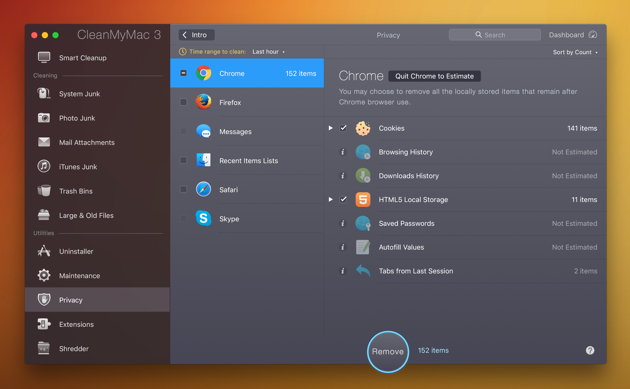
Or you can even use CleanMyMac’s smart Junk Cleanup tool that not only removes Chrome cache files, it also gets rid of “temporary” files that clog up your system. By the way, you can download CleanMyMac for free and try it.
A better performing Mac and a better performing Chrome all in one go.
Google Chrome Keeps Crashing
Chrome freezing is one thing but crashing? That’s a much bigger issue as it’s a sign that something is broken. But what do we do with things that are broken around here? We fix them!
Probably the most common cause of crashes is a byproduct of one of Chrome’s strengths – its constant stream of exciting extensions. They make our browser experience more enjoyable and productive, but occasionally one of these extensions will be corrupted or introduce a bug that causes Chrome to crash.
Here’s what you should do to find a problematic Chrome extension.
Update everything. Make sure Chrome is updated to the latest version as well as each extension that you use. A new update could very well include the fix that will stop Chrome crashing.
If that didn’t work or everything was already up-to-date, you can manually turn off your extensions and turn them back on, one at a time. This way, if the crashing goes away until a certain extension is turned back on – that’s when you’ve probably found the problem.
To manually disable and remove Chrome extensions:
- Open Chrome and go to Settings > Extensions
- Disable all the extensions by unchecking them
- Relaunch Chrome
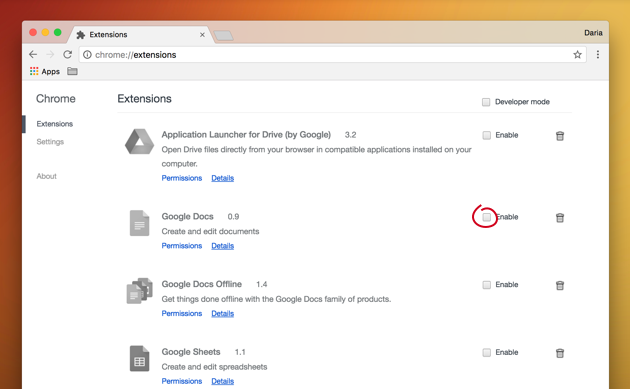
Spend some time using Chrome without extensions and then slowly turn each one back on until your crashing returns. When you think you have the culprit, simply click the trashcan next to that extension in Settings > Extensions.
An even easier way to manage your extensions is with CleanMyMac 3. You get more control over all your extensions, even those from other browsers, and disabling and removing them is as easy as can be.
To disable Chrome extensions the simple way:
- Click on the Extensions tab in CleanMyMac
- Click on Chrome Extensions and disable as you like
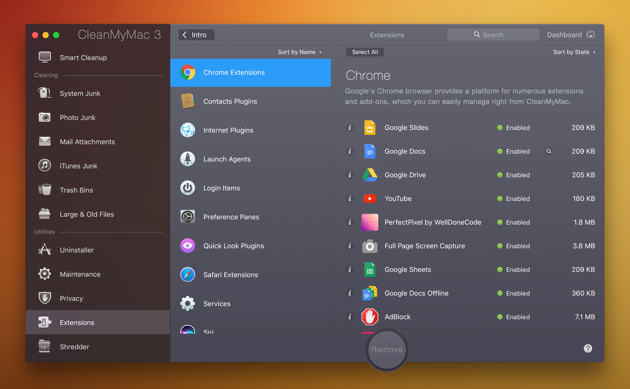
Web Pages Not Loading in Chrome
“Aw snap!”
This is Chrome’s custom message for when a web page fails to load. If you get this cheeky little message or any other loading error, chances are you’re going to fail to see the funny side.
The reasons for Chrome not loading pages can be wide-ranging and hard to pinpoint, but we’ve collected a checklist of fixes for you to work through.
- Check your internet connection
- Update Chrome
- Restart your Mac
- Remove Chrome extensions (for steps see Google Chrome Keeps Crashing)

If you’re still unable to load web pages, a reset or reinstall of Chrome may be needed. We cover that very fix in the next section.
Chrome Update Failed
Chrome won’t update? Some users have experienced the frustration of Chrome refusing to update on a Mac. The first step would just be patience, but if days have passed and you’re still not getting anywhere, a reset or reinstall of Chrome may be in order.
To reset Chrome manually:
- Launch Chrome and go to Settings
- Scroll to the bottom and click on Advanced Settings
- Scroll to the bottom and click on Reset Settings
- Read the pop-up and Reset
- Relaunch Chrome and try update
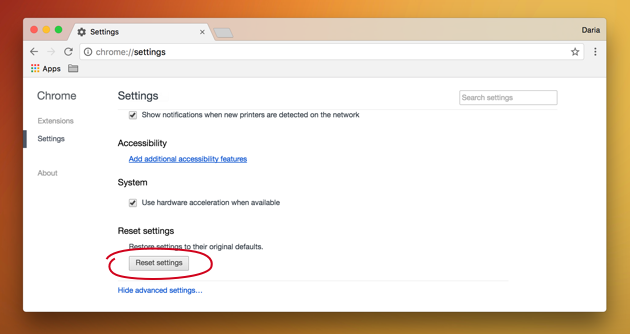
Note - resetting Chrome will not remove your bookmarks, history, and saved passwords. A manual reset can be a bit scary, so why not use the reset function in CleanMyMac to make sure it’s done right?
Reset Chrome with CleanMyMac:
- Go to Uninstaller > Google Chrome
- Click Reset at the bottom of the screen

If the browser is still not updating, download the latest installation file from the web and reinstall Chrome.

Chrome settings
Your Chrome browser should now be running great, but wait; there’s more! To improve your future browsing experience we’re sharing some of our favorite Chrome settings. Try these out and fall in love with Chrome even more.
Enable Prefetch
Want your web pages to load even faster? Go to Settings > Advanced Settings > Privacy and make sure “prefetch” is turned on. Now resources will be stored on your system to be loaded automatically next time a page is visited.
Use Experimental Features
Within Chrome are a number of hidden features that are still being developed. To access these features type chrome://flags into the address bar and hit Enter. Now you can…
- Get smooth scrolling by searching for enable-smooth-scrolling and turning it on.
- Find Number of Raster Threads and change from “default” to “4” to speed up image loading.
- Enable Experimental Canvas Features to boost page loading times.
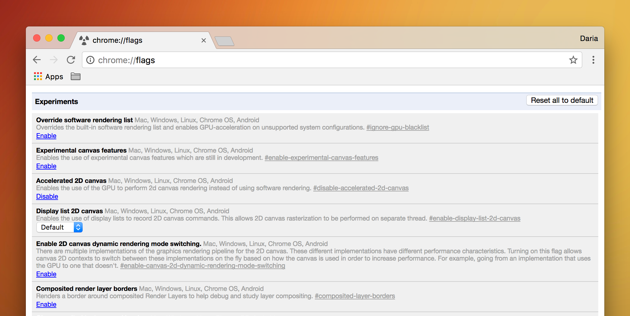
Note – Chrome must be restarted for the effects to take place. To undo these changes click “reset all to default” on the flags page.
Use Shortcuts in Chrome browser
Okay, it’s not a setting, but you’d be amazed at how much faster you can surf the web and get things done by learning just a few key shortcuts.
For example:
Command + t = new tab
Command + h = hide Chrome
Command + r = reload web page
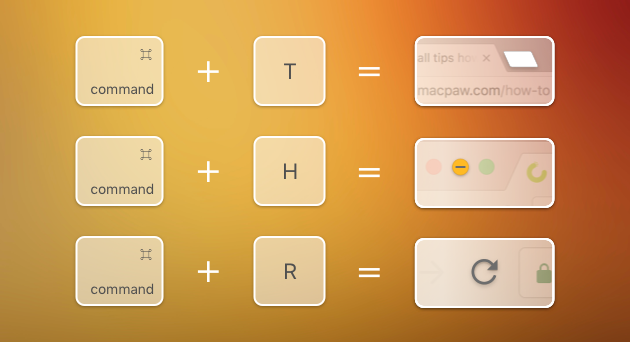
The full list of commands can be found at the official Google Chrome Support page.
That’s how you fix Google Chrome
It’s annoying to hear how great Chrome is on Mac when you’re experiencing all sorts of Google Chrome problems.
Hopefully, these fixes have made your web surfing better than it’s ever been. It just goes to show that even drastic problems like Chrome crashing can be solved with a little know-how and helpful apps like CleanMyMac.




No comments:
Post a Comment